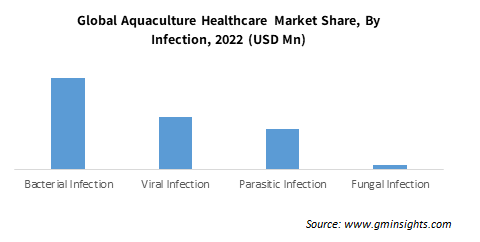Home > Animal Health & Nutrition > Veterinary Services > Aquaculture Healthcare Market
Aquaculture Healthcare Market Analysis
- Report ID: GMI4536
- Published Date: Dec 2022
- Report Format: PDF
Aquaculture Healthcare Market Analysis
In terms of product, the aquaculture healthcare market share from the medicated feed additives segment is foreseen to record significant growth at over 10% CAGR through 2032. The segment is further classified into topical treatments, amino acids, antioxidants, enzymes, antibiotics, minerals, hormones, prebiotics and probiotics, and vitamins. Medicated feed additives include medications or antibiotics that assist aquaculture farmers in lowering the risks of illnesses, infections, or diseases in aquatic creatures as well as in increasing the nutritional value and quality of food, which is expected to positively influence their uptake through 2032.
On the basis of species, the fish segment of the aquaculture healthcare market accounted for over USD 775 million in revenue in 2022, the report claims. The need for aquaculture healthcare solutions has increased due to the rising demand for high-quality fish proteins, which is slated to boost segment development. The flourishing fish farming sector, which requires better fish productivity, is projected to be a significant driver impelling the business growth through 2032.

Aquaculture healthcare market is bifurcated by infection into bacterial infection, viral infection, parasitic infection, and fungal infection. The parasitic infection segment is foreseen to surpass USD 450 million by 2032. The increased vulnerability of aquatic species to parasites, such as sea lice and sea fleas has resulted in an upsurge in the demand for parasitic infection medications. For instance, salmon are highly vulnerable to sea lice infection. Furthermore, the development of novel treatments and innovative solutions to treat these infections is expected to stimulate segment trends.
As per the route of administration, the aquaculture healthcare market is segregated based on oral, topical, and injectable. The topical segment is anticipated to register more than USD 735 million by 2032, the study cites. Topical therapeutics lower the handling stress for fish and improve the outcomes, making them a highly popular alternative solution among fish farmers. Additionally, smaller fish and fry require topical immunizations before they can be vaccinated, boosting the demand for topical treatments, which is speculated to support segment expansion through 2032.
The aquaculture healthcare market is segmented based on distribution channels into retail/aqua stores, distributors, online stores, and others. The retail/aqua stores segment is estimated to generate more than USD 460 million in revenue by 2032 owing to the access to numerous therapeutic solutions at retail stores. The increasing availability of specialty products stocked for aquatic animals at aqua stores is estimated to fuel segment expansion.

Asia Pacific aquaculture healthcare market is poised to grow at more than 9.5% CAGR through the forecast timeline. Several APAC nations, including Thailand, India, China, and Indonesia, are among the world's largest producers of crustaceans, resulting in growing regional demand for crustacean therapeutic products. Furthermore, surging awareness among fish farmers about the significance of aquaculture healthcare is likely to contribute to increased product adoption, thereby propelling regional market outlook.

